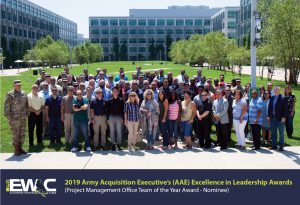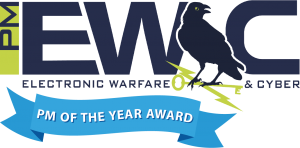Electronic Warfare has evolved.
 In August 1914, a British cable laying ship, the Telconia, found and cut five German communications lines that ran under the English Channel. A few days later the Telconia returned to the scene, picked up the cables and reeled them aboard to prevent German forces from reestablishing their capability.
In August 1914, a British cable laying ship, the Telconia, found and cut five German communications lines that ran under the English Channel. A few days later the Telconia returned to the scene, picked up the cables and reeled them aboard to prevent German forces from reestablishing their capability.
Fast forward to 2020 and degrading and destroying enemy abilities is still a key mission in Electronic Warfare (EW). Many things have changed; with attacks and attackers shrinking down to the size of a laptop; but the damage can be exponential from even just one laptop. Project Manager Electronic Warfare & Cyber’s whole purpose is to create, test and field the new tools of the next decades of EW.
For their efforts, PM EW&C has earned the PM of the Year Award.
From Aug. 1, 2018 to July 31, 2019, the PM EW&C Project Management Office was at the forefront of ensuring the Army’s modernization priorities in terms Electronic Warfare and Cyber. Using lessons learned from near peer actions in Crimea and the Ukraine, PM EW&C pushed to close a critical capability gap in record time.
“The team fielded the Army’s first new electronic warfare capabilities in over a decade including the Electronic Warfare  Planning and Management Tool (EWPMT),” their award write up said. “As well as rapidly developed mounted and dismounted EW and cyber systems. The office began engineering and manufacturing development on an airborne Multi-Function Electronic Warfare (MFEW) system. Working closely with Training and Doctrine Command (TRADOC), the office achieved true cross-portfolio integration with the convergence of electronic warfare, cyber, and signals intelligence (SIGINT) to optimize the employment of capabilities necessary for Multi-Domain Operations. Today, Warfighters in Europe and rotational Brigade Combat Teams have the tools to implement electronic protection for their formations, detect and understand enemy activity in the electromagnetic spectrum, and disrupt adversaries through electronic attack effects.”
Planning and Management Tool (EWPMT),” their award write up said. “As well as rapidly developed mounted and dismounted EW and cyber systems. The office began engineering and manufacturing development on an airborne Multi-Function Electronic Warfare (MFEW) system. Working closely with Training and Doctrine Command (TRADOC), the office achieved true cross-portfolio integration with the convergence of electronic warfare, cyber, and signals intelligence (SIGINT) to optimize the employment of capabilities necessary for Multi-Domain Operations. Today, Warfighters in Europe and rotational Brigade Combat Teams have the tools to implement electronic protection for their formations, detect and understand enemy activity in the electromagnetic spectrum, and disrupt adversaries through electronic attack effects.”
Col. John Transue, Director of the Army Capability Manager – Cyber (ACM Cyber) for TRADOC, works very closely with PM EW&C, “on a daily, weekly and quarterly touch basis with the PM,” said Transue. Transue works out of Fort Gordon, one of the major hubs of Electronic warfare training. “We work with the operational forces to observe operations, obtain the lessons learned for the material solution and host the workgroups for the operators and the PM.”
Those workgroups are critical to getting the current and next generations of Electronic Warfare professionals ready not only to do their jobs, but engage in the constant cycle of improvement that the software and hardware and electronic warfare will require.
“We conduct monthly and quarterly offensive cyber operations workshops to discuss current status of efforts and look forward to the 2025 and 2028 operational environment.” said Transue. “The PM works closely with the operators to quickly enhance the capabilities and evolve them to meet the initial minimum value and then constantly getting better based on that user feedback. The PM’s efforts is an excellent example of that ‘DevOpsSec’ model that provides faster delivery, affordable solutions, focused improvements, and identify and manage risk.”
DevOpsSec along with two other versions OpsSecDev and DevSecOps collectively refer to Development Operations and Information Security in different orders. What you are building software-wise determines the order and the Army has been building countless software systems in different orders of priority and increasing levels of complexity based on every factor the Acquisition Corps can think of.
Methods like that are facilitated and augmented by many hours working with electronic warfare officers from across the globe. Capt. Sacarra Pusey, an Electronic Warfare Officer hailing from Fort Polk, La., was enthusiastic to give feedback.
“They’ve brought us back to continue to assess the equipment,” said Pusey of her experience assessing the EWPMT. “My NCO’s were able to talk to [the engineers] and give updates, and feedback like ‘can we have the right click capability, can we have the alerts hidden, can we talk through the chat,’ and as we went through the steps in the processes a lot of the kinks were taken care of.”
Pusey could see the EWPMT being useful in visualizing the role of Electronic Warfare to a combatant commander.
“We [electronic warfare personnel] are tech savvy, but if I show the Colonel what I’m seeing in the EWPMT, that helps explain that message that I’m trying to get across. He’ll hear we’re ‘producing effects along this line’ in the vicinity of something, but if I show him the coverage map, he will see that piece much more clearly.” Pusey went on to say that further testing events allow her to coordinate with other military specialists who may work in a different aspect of EW or parallel skill like radio communication. Further these exercises allowed Pusey and her Soldiers to consider and envision opposing forces as well.
Pusey went on to say that further testing events allow her to coordinate with other military specialists who may work in a different aspect of EW or parallel skill like radio communication. Further these exercises allowed Pusey and her Soldiers to consider and envision opposing forces as well.
That PM EW&C enables that degree of training is large part of why they got the award.
“This significant achievement highlights your team’s demonstrated dedication to mission accomplishment and extraordinary professionalism,” said Dr. Bruce Jette, United States Assistant Secretary of the Army for Acquisition, Logistics, and Technology in an award note he sent. “I am reminded once again that the Army’s greatest strength is our people.”
Col. Kevin Finch, the Program Manager, agrees with the Assistant Secretary, when he said “EW&C is staffed by the best and brightest I have worked with in my career, the military, the DA civilians, the contractors, the engineers and programmers: those are the people who make things happens and they are the people that earned this award.”
“People, whether it’s Army capability managers or the Soldiers out in the field or vendors, no matter who it is, they are always working together to build better capabilities to get the best possible product out; to get to ‘yes’ with all our products. I’m just proud to be associated with them and I couldn’t ask for a better bunch of folks. With our vendors, we’re partners, not customers, working together to build the best possible capabilities.”
Those people that Finch and Jette speak so highly of managed a combined budget of $2.4 billion over the Future Years Defense Program to include cost, performance, and schedule of over $400 million annually in assigned programs. EW&C consists of five product management offices: Product Manager Information Warfare, Product Manager Electronic Warfare Integration, Product Manager Prophet, Product Director Electronic Attack, Product Lead Tactical Space Superiority, and they are responsible for the development, acquisition, production, fielding, and sustainment of two Acquisition Category (ACAT) II programs, five ACAT III programs, four ACAT IV programs, and twelve Quick Reaction Capabilities that support operations around the planet.
By John Higgins PEO IEW&S Public Affairs

